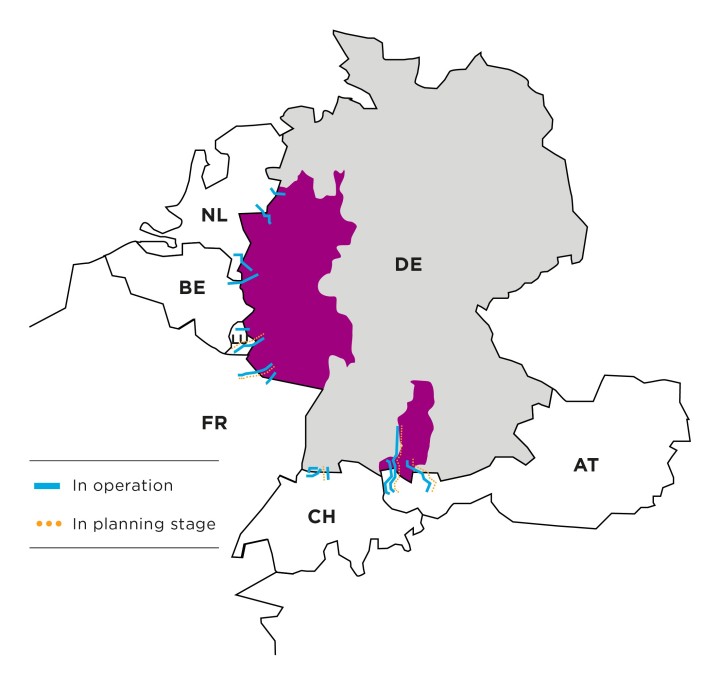Connecting grids
The national grids are linked by cross-border lines called “interconnectors” to form an interconnected European network. These “power bridges” make the national grids more secure, and electricity in Europe cheaper overall. If, for instance, a power plant in Germany has to be disconnected from the grid unscheduled, another in the neighbouring region can supply the necessary power via an interconnector. What’s more, the internationally available power can be transported right across Europe via the cross-border connections and thus used in the best possible way. Amprion’s grid is already connected to the transmission systems in the Netherlands, Belgium, Luxembourg, France, Switzerland and Austria. Five more interconnector projects are planned.

The map indicates the interconnectors linking the Amprion power grid with neighbouring national grids
Grid expansion for Europe’s energy transition
A more efficient and flexible European transmission network is needed to achieve the climate targets by the European Commission. To this end, the transmission system operators are planning and building additional power connections between the nations. In order to define the expansion requirements for the next ten years as accurately as possible, every two years, as part of their cooperation within the European Network of Transmission System Operators for Electricity (ENTSO-E), all European TSOs draw up a new Ten-Year Network Development Plan (TYNDP). This is based on forecasts of how power generation and consumption will develop in Europe. In addition to the grid expansion requirements, the TYNDP also presents innovative technical solutions and special technical issues concerning the further development of Europe’s transmission grid in separate reports.
Amprion is represented in the TYNDP with several interconnector projects, including the German-Belgian power bridge named ALEGrO, which went into operation end of 2020, and a possible second expansion of capacity on this border. In addition, the Vigy – Uchtelfangen connection to France and the Tiengen – Beznau line to Switzerland are to be upgraded as well as the Vöhringen – Westtirol line and the Lake Constance lines to Austria. Other projects within Germany, such as Ultranet, A North and Corridor B, which are of particular importance for the European energy grid, are also part of these plans.
PCIs – Projects of common interest
Together with the member states, the regulatory authorities and transmission system operators, the EU Commission identifies grid expansion projects of particular interest to Europe – what are called “ projects of common interest” (PCIs). The precept is that the projects have a positive economic, social and environmental impact on at least two member states. One of the goals of PCIs is to help upgrade the electricity and gas networks so that they are capable of absorbing and transmitting the increasing volumes of energy generated by renewable sources. The projects are also intended to support sustainability and system security. At the same time, certain planning and approval procedures apply, which are controlled by the relevant national authority.
The EU Commission publishes an updated list of PCI projects every two years. It includes the DC links Ultranet and the reinforcement of the Reutlingen - Herbertingen power line planned by Amprion.
e-Highway2050: The future of Europe’s energy supply
A European research consortium, supported by the European Commission, has launched a project entitled “e-Highway2050”. The aim was to develop a long-term planning methodology for the expansion and restructuring of Europe’s transmission grids. The target date set by the project partners is 2050: by then, AC and DC power lines will hopefully be interwoven to form a high-capacity pan-European grid capable of absorbing large volumes of electricity from renewables and transmitting them over long distances.
Amprion joined other European TSOs in the necessary research work, which produced some important findings: all five project scenarios examined confirmed that the grid expansion projects in Germany are both expedient and necessary. What’s more, looking ahead to 2050 revealed that an integrated European grid, in which today’s AC links are upgraded and consolidated by individual HVDC links, is fit for the challenges of the future. Another positive: the project developed planning methodologies for long-term network development that were made available to all ENTSO-E members and some of which have already been utilised in the TYNDP.